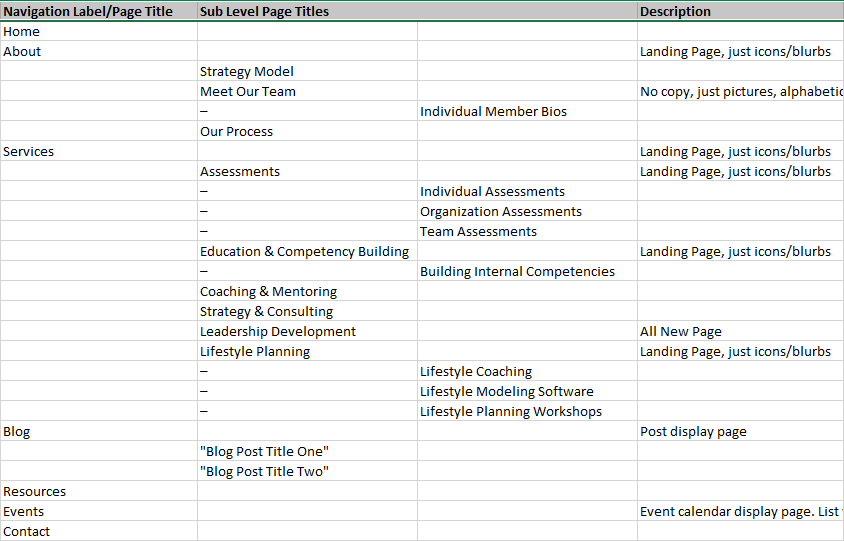A website redesign is exciting. It is an opportunity to give your business’ online representation a new look and feel. But there is good information on your existing website, so this is also a chance to review and audit your old website and all your marketing collateral.
The fruits of these reviews will certainly come through in the web copy as you decide what needs to be included, rewritten, removed, added and so on. When it comes to a website redesign, you have three roads to take for web copy: just plug and chug your old copy, have your web design agency rewrite it for you (if they offer that service) or take on the endeavor of writing or rewriting the bulk of copy yourself.
A lot of businesses prefer the last approach and it’s hard to blame them. They are the expert in their field or service and are probably the most qualified and knowledgeable to write about their business and their industry.
However, many unprepared businesses quickly find out that tackling the entirety of their website’s copy is a taller order than they anticipated. Whether the struggle is finding the time to write and proof copy during the course of a typical business day or any number of other reasons, web copy can cause a web project to get bogged down, derailed or otherwise delayed.
While it’s important that you are happy with the content on your website – no matter how long it takes – it’s also important to be able to meet crucial deadlines so your new site can come alive. If you’ve recently taken on the challenge or have been considering taking this path, let me give you a couple of pointers to help your project stay on track and reach completion sooner, rather than later.
Start with a Site Map
Before you write a single word, you can help yourself tremendously by preparing a blueprint for your website. For a website, this “blueprint” is called a Site Map.

Building your own Site Map is as easy as opening up an Excel spreadsheet (or a word doc if Excel gives you a headache) listing out every page for your website. Start with the navigation and then move on to pages within those pages.
Laying everything out like this gives you perspective. From here you can decide how much help you’re going to need, determine exactly how big the site is going to be and clearly define missing pages. It also helps to leave some space for you to leave notes such as prioritizing pages that are going to need the most work and require your main focus and track progress. This is especially helpful if you have multiple people involved in the project.
Don’t obsess about writing “final copy”
While it is important that your web copy is in a good place that you are happy with upon launch, sometimes web projects can get bogged down by perfectionism. Listen, as a perfectionist myself, it is sometimes painful to let things slide. But here’s the reality: a website is a constantly changing and evolving beast.
You will be constantly changing and tweaking your website’s appearance and content months, maybe even years, down the road. The point I’m trying to get at is that the copy you have on your website on launch day is not set in stone. You have the power to change, remove and add whatever you want.
So if your project is taking longer because you are constantly tweaking and second-guessing pages of copy that have already been written, approved, re-written and re-approved – stop! The most important thing is that the copy is in a state that is “launch ready.” Maybe the wording isn’t absolutely perfect or there is a small element that is still missing, but you can always change it later on.
Collaborate and be open to change
Taking on an entire web copy rewrite can be a daunting task – don’t be afraid to ask for a little backup. Collaborate within your organization. You can delegate work on different pages to different people or different departments who may be more knowledgeable in a particular area. Collaboration and delegation not only helps take the pressure off you but also opens up different ways of presenting and articulating the information.
Others may have a different take or way of presenting copy, but be open to it. Just because it’s not how you would have done it doesn’t mean it’s not worth your time.
Just make sure you keep up a good level of communication to ensure things get done on time, the right pages are being worked on and you have enough time to review. You had to work in group projects in school right?
Set reasonable goals
Above everything else when setting your course on a web project, the most important thing is to be realistic in your goals. The worst thing you can do is back yourself into a corner. Anticipate that there will be hiccups and distractions along the way when you are setting deadlines. Think about trade shows, vacations or other events on your calendar that will demand days or weeks of your attention.
Also take into account your own schedule and writing talents. You may not be the fastest writer, but that’s fine. This is your project and it’s important that you have a heavy hand in its creation.
Now that you know how to write, it’s time to think about what to write. Check out my blog post about how to write great web copy so your project is not only completed promptly, but also reads great for your customers.
